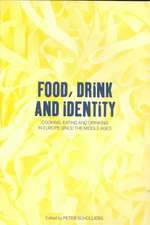A Taste of Progress: Food at International and World Exhibitions in the Nineteenth and Twentieth Centuries
Autor Nelleke Teughels, Peter Scholliersen Limba Engleză Hardback – 28 oct 2015
| Toate formatele și edițiile | Preț | Express |
|---|---|---|
| Paperback (1) | 427.16 lei 6-8 săpt. | |
| Taylor & Francis – 16 iun 2017 | 427.16 lei 6-8 săpt. | |
| Hardback (1) | 1007.72 lei 6-8 săpt. | |
| Taylor & Francis – 28 oct 2015 | 1007.72 lei 6-8 săpt. |
Preț: 1007.72 lei
Preț vechi: 1228.92 lei
-18% Nou
Puncte Express: 1512
Preț estimativ în valută:
192.82€ • 201.87$ • 159.55£
192.82€ • 201.87$ • 159.55£
Carte tipărită la comandă
Livrare economică 05-19 aprilie
Preluare comenzi: 021 569.72.76
Specificații
ISBN-13: 9781472441836
ISBN-10: 1472441834
Pagini: 348
Ilustrații: Includes 37 b&w illustrations
Dimensiuni: 156 x 234 x 27 mm
Greutate: 0.67 kg
Ediția:New ed
Editura: Taylor & Francis
Colecția Routledge
Locul publicării:Oxford, United Kingdom
ISBN-10: 1472441834
Pagini: 348
Ilustrații: Includes 37 b&w illustrations
Dimensiuni: 156 x 234 x 27 mm
Greutate: 0.67 kg
Ediția:New ed
Editura: Taylor & Francis
Colecția Routledge
Locul publicării:Oxford, United Kingdom
Cuprins
Preface; Introduction, Nelleke Teughels; World’s fairs in perspectives. The aggregation of modern times and spaces at the beginning of the 20th century (Ghent 1913), Wouter Van Acker and Christophe Verbruggen. Part I Culinary Nation-building: Gastronomy at the Exposition internationale des arts et techniques dans la vie moderne, Paris 1937, Alain Drouard; Discovering Latin American food at world’s fairs, Jeffrey M. Pilcher; Food exhibitions as places of national representation and international exchange: the international exhibitions of culinary art in Frankfurt/Main (1900-1911), Eva Coydon; Cheap and nutritious domestic food for all: the first food fair in Finland, 1926, Kaija Rautavirta and Antti Ahlström; Rome 1911: the ‘living-table’, a picture of the young Italian nation, Margherita d’Ayala Valva; We're good enough to host the world! Czech and Slovak cuisine at world fairs in 1958, 1967, and 1970, Martin Franc. Part II National Appropriation: ‘Belgian waffles’ made in the USA. World’s fairs and the exploitation of national adjectives for food, Marc Jacobs in collaboration with Alan Govenar; Food at the 1910 Brussels Exhibition: spaces of consumption and the articulation of national identity, Nelleke Teughels; Constructing Roquefort cheese at universal exhibitions, 1851-1914, Sylvie Vabre. Part III Culinary Encounters: Food, Identity and Cultural Mediation: Sensing the colonies at the 1889 and 1900 Universal Exhibitions, Van Troi Tran; Food and drink at the 1939 World's Fair: national rivalry and Irish aspiration, Bryce Evans; Joining the civilized world: Europe’s northern periphery meets American food culture at world fairs, Ritva Kylli. Part IV Catering to the World: Foreign hospitality workers at the 1910 Brussels World and International Exhibition, Patricia Van den Eeckhout; Catering for millions: the British Empire Exhibition, 1924-25 and the Festival of Britain, 1951, Derek J. Oddy; How like England we can be: feeding and accommodating visitors to the international exhibitions in the British colonies of Australia in the 19th century, Diana Noyce; Conclusion: the multiple, wide-ranging and complex facets of food at large exhibitions, Peter Scholliers and Nelleke Teughels. Index.
Notă biografică
Nelleke Teughels is Postdoctoral Researcher in Social and Cultural Food Studies and Peter Scholliers is Professor of History and Director of Research in Social and Cultural Food Studies, both at Vrije Universiteit Brussel, Belgium.
Descriere
World exhibitions have been widely acknowledged as important sources for understanding the development of the modern consumer and urbanized society, yet whilst the function and purpose of architecture at these major events has been well-studied, the place of food has received very little attention. Food stood as a powerful semiotic device for communicating and maintaining conceptions of identity, history, traditions and progress, of inclusion and exclusion, making it a valuable tool for researching the construction of national or corporate sentiments. Combining recent developments in food studies and the history of major international exhibitions, this volume provides a refreshing alternative view of these international and intercultural spectacles.










